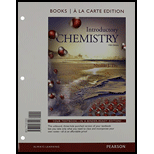
Interpretation: The correct name for each of the given formula is to be identified. In case of incorrect name, the correct name is to be provided.
Concept Introduction: A compound that is composed of a metal and a non-metal is known as an ionic compound.
Compounds that are composed of two non-metals are termed as molecular compounds.
Element having the metallic character is named first while naming an ionic compound.
Prefixes indicate the number of atoms present in each element.
If only one atom of the first element in the formula is present, the prefix mono is generally omitted.
Polyatomic ions comprise of groups of atoms that have an overall charge.
In order to name the ionic compounds that contain the polyatomic ion as an anion, write the name of the cation followed by the name of the polyatomic ion.
Want to see the full answer?
Check out a sample textbook solution
Chapter 5 Solutions
Introductory Chemistry, Books a la Carte Edition & Modified MasteringChemistry with Pearson eText -- ValuePack Access Card -- for Introductory Chemistry Package
- Write the formula for each of the following compounds: a. ammonium hydrogen phosphate b. mercury(I) sulfide c. silicon dioxide d. sodium sulfite e. aluminum hydrogen sulfate f. nitrogen trichloride g. hydrobromic acid h. bromous acid i. perbromic acid j. potassium hydrogen sulfide k. calcium iodide l. cesium perchloratearrow_forwardThe formulas MgO and CO look very similar. What is the name for each compound? Why do we name them differently?arrow_forwardThe formula of barium molybdate is BaMoO4. Which of the following is the formula of sodium molybdate? (a) Na4MoO (b) NaMoO (c) Na2MoO3 (d) Na2MoO4 (e) Na4MoO4arrow_forward
- What is the difference between molecular compound and ionic compound? Cite some examples that can be found in our home.arrow_forwardMolecular or Ionic Compound? Compound Name B2O3 2 N2O 3 LiCl 4 N2O4 5 BrF3 6 AlBr3 7 SnF2 8 SiCl4 9 NaCl 10 TiCl3 11 CuF2 12 SF6 13 P4S3 14 Xe3F4 15 PtCl2arrow_forwardName each ionic compound. a. KF b. ZnCl 2c. Cu 2S d. SnO e. AuBr 3f. Li 2S g. SnBr 4arrow_forward
- We+2 Werium A+1 Almostium Du-3 Dunium Y-2 Yeasium 1. Use the elements above to create a model that shows how an atom becomes charged and explain your model. 2. Use the elements above to create a model that shows how atoms combine to form an ionic compound. (Lewis Dot) Write the correct chemical formula for your compound. Explain how you predicted the chemical formula using nomenclature rules Name the compound Explain why the name is correct according to nomenclature rules. 3. Use the elements above to create a model that shows how atoms combine to form a molecular compound. (Lewis Dot) Write the correct chemical formula for your compound. Explain how you predicted the chemical formula using nomenclature rules Name the compound Explain why the name is correct according to nomenclature rules. 4. Explain how your models show that elements combine in whole number ratios.arrow_forwardAg2O what is the name of this formula? SnS2 what is the name of this formula? ? Pa3N2 what is the name of this formula?arrow_forwardName this compound: Ba(NO3)2arrow_forward
 World of Chemistry, 3rd editionChemistryISBN:9781133109655Author:Steven S. Zumdahl, Susan L. Zumdahl, Donald J. DeCostePublisher:Brooks / Cole / Cengage Learning
World of Chemistry, 3rd editionChemistryISBN:9781133109655Author:Steven S. Zumdahl, Susan L. Zumdahl, Donald J. DeCostePublisher:Brooks / Cole / Cengage Learning Chemistry: The Molecular ScienceChemistryISBN:9781285199047Author:John W. Moore, Conrad L. StanitskiPublisher:Cengage Learning
Chemistry: The Molecular ScienceChemistryISBN:9781285199047Author:John W. Moore, Conrad L. StanitskiPublisher:Cengage Learning Chemistry & Chemical ReactivityChemistryISBN:9781133949640Author:John C. Kotz, Paul M. Treichel, John Townsend, David TreichelPublisher:Cengage Learning
Chemistry & Chemical ReactivityChemistryISBN:9781133949640Author:John C. Kotz, Paul M. Treichel, John Townsend, David TreichelPublisher:Cengage Learning Chemistry: An Atoms First ApproachChemistryISBN:9781305079243Author:Steven S. Zumdahl, Susan A. ZumdahlPublisher:Cengage Learning
Chemistry: An Atoms First ApproachChemistryISBN:9781305079243Author:Steven S. Zumdahl, Susan A. ZumdahlPublisher:Cengage Learning Introductory Chemistry: An Active Learning Approa...ChemistryISBN:9781305079250Author:Mark S. Cracolice, Ed PetersPublisher:Cengage Learning
Introductory Chemistry: An Active Learning Approa...ChemistryISBN:9781305079250Author:Mark S. Cracolice, Ed PetersPublisher:Cengage Learning





